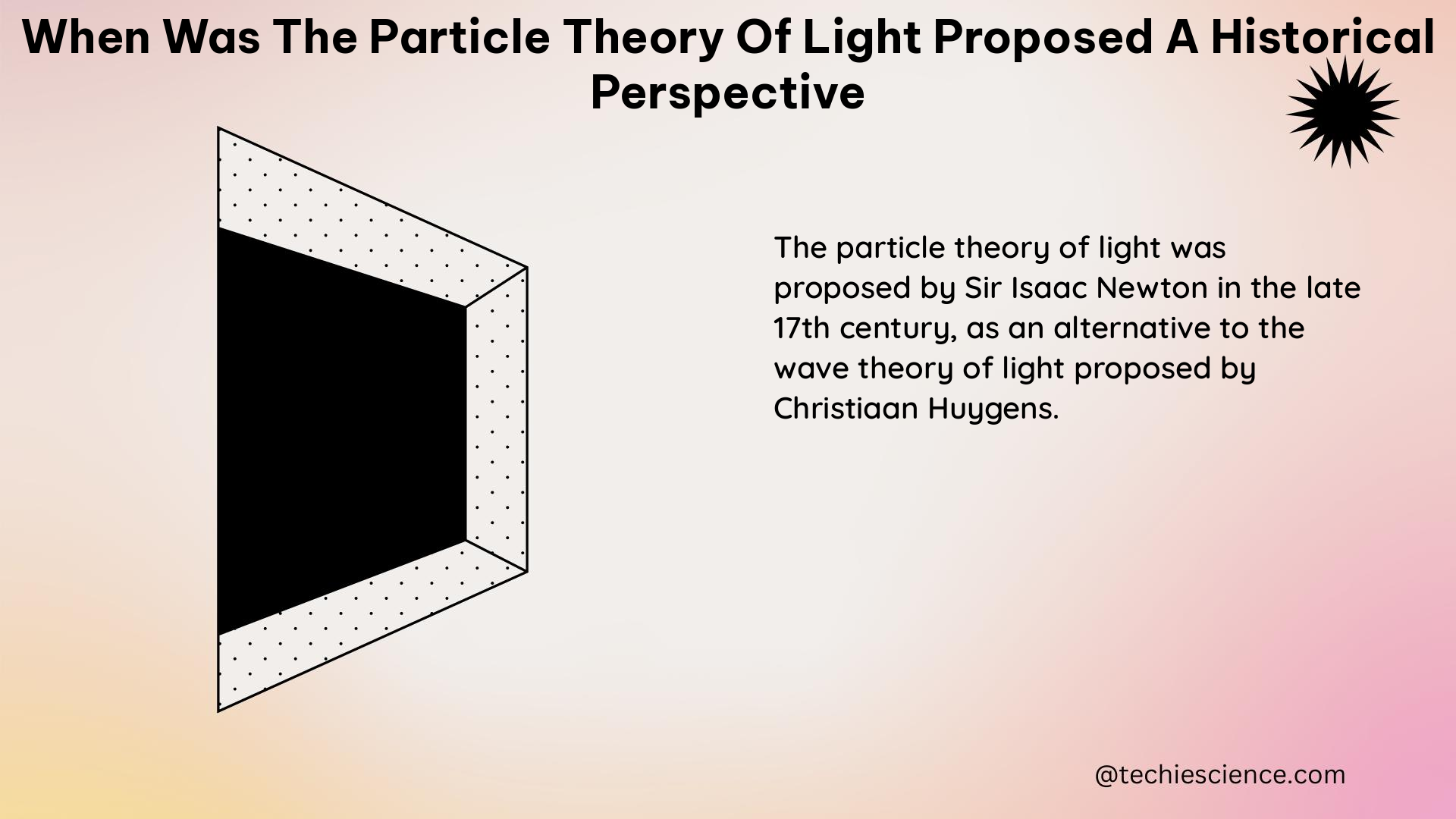The particle theory of light, proposed by Sir Isaac Newton in the late 17th century, posits that light consists of a stream of particles called “corpuscles.” This theory, detailed in Newton’s 1704 publication “Opticks,” dominated the scientific understanding of light for over a century until the early 19th century, when evidence for the wave nature of light became overwhelming.
The Origins of the Particle Theory
Christiaan Huygens and the Wave Theory of Light
In 1690, Dutch physicist Christiaan Huygens formulated the first detailed wave theory of light in his treatise “Traité de la Lumière.” Huygens proposed that light propagates as a wave, similar to the way sound waves travel through a medium. This wave theory was able to explain various optical phenomena, such as reflection, refraction, and diffraction.
Isaac Newton and the Corpuscular Model
Despite the success of Huygens’ wave theory, in 1704, Sir Isaac Newton published “Opticks,” where he proposed that light consists of a stream of particles, or “corpuscles.” Newton’s particle theory was based on his observations of the rectilinear propagation of light, as well as the phenomenon of reflection and refraction.
Newton’s particle theory of light was supported by several key principles:
- Rectilinear Propagation: Newton observed that light travels in straight lines, similar to the motion of particles.
- Reflection: Newton explained reflection as the bouncing of light particles off a surface, similar to the way a ball bounces off a wall.
- Refraction: Newton attributed refraction to the different speeds of light particles in different media, causing them to bend as they pass from one medium to another.
Newton’s particle theory of light was widely accepted for over a century, as it was able to explain many optical phenomena observed at the time.
The Challenge to the Particle Theory

Thomas Young and the Interference Experiments
In 1801, Thomas Young performed a series of interference experiments that provided strong evidence for the wave nature of light. Young’s double-slit experiment demonstrated the interference patterns produced by light, which could only be explained by the wave theory of light.
Young’s experiments challenged the prevailing particle theory of light and provided support for Huygens’ wave theory. The interference patterns observed in Young’s experiments could not be reconciled with the particle model of light.
The Emergence of the Wave-Particle Duality
As the 19th century progressed, more evidence for the wave-like behavior of light continued to accumulate. However, the particle-like behavior of light was also observed in various phenomena, such as the photoelectric effect and the Compton effect.
In the early 20th century, the concept of wave-particle duality emerged, which reconciled the seemingly contradictory properties of light. This idea, developed by physicists such as Max Planck, Albert Einstein, and Arthur Compton, suggested that light exhibits both wave-like and particle-like characteristics, depending on the experimental conditions.
Theoretical and Quantifiable Data
Einstein’s Equation for Photon Energy
In 1905, Albert Einstein proposed the equation for the energy of a photon, which is given by:
( E=hf )
where:
– ( E ) is the energy of the photon
– ( h ) is the Planck constant (6.626×10(^{-34}) J⋅s)
– ( f ) is the frequency of the light
This equation, derived from the photoelectric effect, provided further evidence for the particle-like nature of light.
Planck’s Constant
The Planck constant, denoted as ( h ), is a fundamental physical constant that represents the smallest possible change in energy. It is a crucial parameter in the understanding of the particle-like behavior of light and other quantum phenomena. The value of the Planck constant is:
( h = 6.626 \times 10^{-34} ) J⋅s
Speed of Light
The speed of light, denoted as ( c ), is a fundamental constant in physics that represents the maximum speed at which all electromagnetic radiation, including light, can travel in a vacuum. The accepted value of the speed of light is:
( c = 299,792,458 ) m/s
Conclusion
The particle theory of light, proposed by Sir Isaac Newton in the late 17th century, was a significant milestone in the understanding of the nature of light. Although the particle theory was able to explain many optical phenomena, it was eventually challenged by the wave theory of light, as demonstrated by the interference experiments of Thomas Young.
The reconciliation of the wave-like and particle-like properties of light, leading to the concept of wave-particle duality, was a crucial development in the history of physics. This understanding paved the way for the emergence of quantum mechanics and the modern understanding of the behavior of light and other fundamental particles.
References
- Olympus Life Science. (n.d.). Is Light a Particle or Wave? – Olympus Life Science. Retrieved from https://www.olympus-lifescience.com/en/microscope-resource/primer/lightandcolor/particleorwave/
- APS News. (2008). May 1801: Thomas Young and the Nature of Light. Retrieved from https://www.aps.org/archives/publications/apsnews/200805/physicshistory.cfm
- Galileo. (n.d.). NEWTON’S PARTICLE THEORY OF LIGHT. Retrieved from http://galileo.phys.virginia.edu/classes/609.ral5q.fall04/LecturePDF/L20-LIGHTII.pdf
- Britannica. (2024). Particle, Wave, Theories – Light. Retrieved from https://www.britannica.com/science/light/Early-particle-and-wave-theories
- Wikipedia. (n.d.). Wave–particle duality. Retrieved from https://en.wikipedia.org/wiki/Wave%E2%80%93particle_duality

The lambdageeks.com Core SME Team is a group of experienced subject matter experts from diverse scientific and technical fields including Physics, Chemistry, Technology,Electronics & Electrical Engineering, Automotive, Mechanical Engineering. Our team collaborates to create high-quality, well-researched articles on a wide range of science and technology topics for the lambdageeks.com website.
All Our Senior SME are having more than 7 Years of experience in the respective fields . They are either Working Industry Professionals or assocaited With different Universities. Refer Our Authors Page to get to know About our Core SMEs.